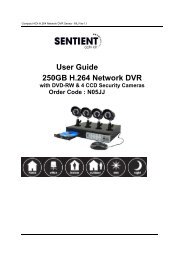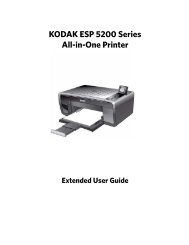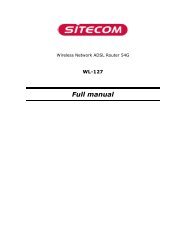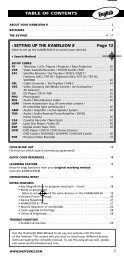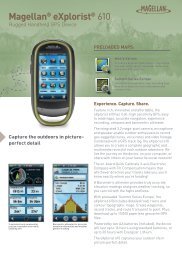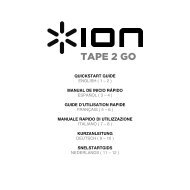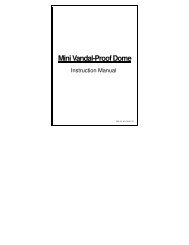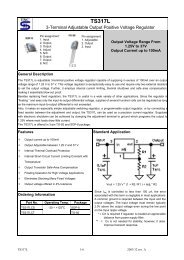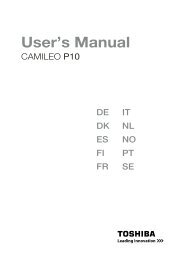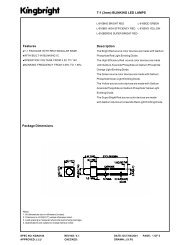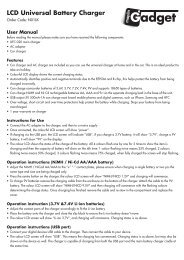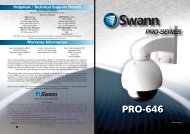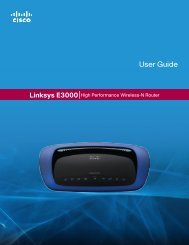Untitled
Untitled
Untitled
Create successful ePaper yourself
Turn your PDF publications into a flip-book with our unique Google optimized e-Paper software.
PREFACE<br />
Congratulations on your purchase of the UBM Solo instrument amplifier with UBM Studio software. This is a versatile and<br />
easy-to-use package that is right at home in a practice room, small performance, or recording studio. UBM Solo's unique USB<br />
functions and UBM Studio software enable a wide variety of applications. Included in this package:<br />
- 1 UBM Solo instrument amplifier<br />
- 1 UBM Studio CD<br />
- 1 USB cable<br />
- 1 User manual<br />
TABLE OF CONTENTS<br />
1. PREFACE ………………………………………………………………………………………………………………….2<br />
2. SAFETY INSTRUCTIONS ……………………………………………………………………….……………….………3<br />
3. UBM SOLO FEATURES…...……………………………………………………………………………………………....5<br />
Top Panel Layout ……...……...…………………………………………………………………………………………….5<br />
Rear Panel Layout……… …………………………………………………………………………………………………..6<br />
4. USING THE UBM SOLO..……………………………………………………………………………………………….…7<br />
The UBM Studio Main Window …………………………………………………………………………..…………..……8<br />
The Channel Strip ……………..……………………………………………………………………………….…….……...9<br />
Installation of UBM studio software…….………………………………………………………..…………….….………10<br />
5. USING UBM SOLO WITH UBM STUDIO….…..………………………………………………………………..……...11<br />
6. USING THE VST PLUG-INS………………….………………………………………………………..…..……….……13<br />
7. TROUBLESHOOTING………………………….……………………………………………………….…..……………14<br />
8. SPECIFICATIONS……………………………….………………………………………………………..………..….….15<br />
2
SAFETY INSTRUCTIONS<br />
The lightning flash with arrowhead symbol inside an equilateral triangle is intended to alert the user to the presence<br />
of conduct "hazardous voltage" within the product′s enclosure, which may be of sufficient magnitude to induce a risk of<br />
electric shock to persons.<br />
The exclamation mark inside an equilateral triangle is intended to alert the user to the presence of important<br />
operating and maintenance (servicing) instructions in the literature accompanying the product.<br />
The apparatus shall not be exposed to dripping or splashing and that no objects filled with liquids, such as vases, shall be<br />
placed on the apparatus.<br />
WARNING: TO REDUCE THE RISK OF FIRE OR ELECTRIC SHOCK, DO NOT EXPOSE THIS APPLIANCE<br />
TO RAIN OR MOISTURE.<br />
The mains plug is used as the power disconnect device, shall remain readily operable.<br />
This symbol means that this unit is double insulated. An earth or ground connection is not required.<br />
1. Caution: To reduce the risk of electric shock,<br />
do not remove cover(or back). No user-serviceable<br />
parts inside. Refer servicing to qualified personnel.<br />
3. Do not install the equipment in a dusty, damp or<br />
poorly ventilated place.<br />
3<br />
2. Do not install the equipment in a place exposed<br />
to direct sunlight.<br />
4. To prevent damage to the equipment, please<br />
unplug from the power outlet if not in use.
5. To unplug the equipment, always handle the<br />
power cord using the plug. Do not pull out the plug<br />
by tugging the cord.<br />
7. Cleaning care: Use a soft, dry cloth for cleaning.<br />
For stubborn dirt, soak the cloth in a weak detergent<br />
solution; wring well and wipe to remove the dirt. Do<br />
not use volatile agents such as benzene or paint<br />
thinner, as they may damage the surface finish of the<br />
equipment.<br />
9. No naked flame sources, such as lighted candles,<br />
should be placed on the apparatus.<br />
SAFETY INSTRUCTIONS<br />
4<br />
6. Place the equipment on a stable surface and<br />
avoid placing other objects on top.<br />
8. Please do not block the cooling vents to avoid<br />
overheating.
TOP PANEL LAYOUT<br />
UBM SOLO FEATURES<br />
The top panel controls as shown in the above figure:<br />
1. Input Jack.<br />
This is an XLR “Combo” jack and can accept the following types of input:<br />
- 1/4” guitar cable<br />
- 1/4” microphone cable<br />
- XLR balanced microphone cable<br />
2. Gain.<br />
This controls the input level of the input jack. It has a wide range to accommodate a variety of inputs (instrument, guitar, bass,<br />
or microphone)<br />
3. Parameter.<br />
This is used with the UBM Studio software and is used to change or edit settings in the software. It has 2 functions:<br />
- Turn to increase/decrease the selected value.<br />
- Press the knob to move to the next parameter in the UBM Studio window<br />
4. Preset.<br />
This is used with the UBM Studio software and is used to change the currently selected preset.<br />
5. Master.<br />
This knob controls the overall volume of the UBM Solo.<br />
6. Power LED.<br />
5
REAR PANEL LAYOUT<br />
UBM SOLO FEATURES<br />
The rear panel connections as shown in the above figure:<br />
1. Power Switch.<br />
Mains power for UBM Solo.<br />
2. Mains cable.<br />
Connect to a 230V mains source.<br />
3. Line Out.<br />
Stereo RCA outputs to connect UBM Solo to an external amp or recording device.<br />
4. Aux In.<br />
Stereo RCA line-level input to connect an external source such as a CD player, iPod, or other instrument.<br />
5. Pedal.<br />
Input connection to the optional foot pedal controller.<br />
6. Headphone.<br />
Stereo headphone output.<br />
7. USB.<br />
USB connection to the host computer<br />
6
USING THE UBM SOLO<br />
The UBM Solo is designed to be easy to set up and use. There are 2 basic ways to use the UBM Solo: standalone mode and<br />
USB mode. UBM Solo automatically switches modes, depending on whether the USB is connected or not.<br />
Standalone mode: The UBM Solo can be used as a “normal' amplifier without a USB connection. Just leave the USB cable<br />
unconnected and the UBM Solo will function as a normal instrument amplifier.<br />
USB mode: Connect the UBM Solo with a USB cable to a host PC running UBM Studio software. The audio input is routed<br />
through the host PC and with the UBM Studio software, it is possible to mix, record and add effects on the computer.<br />
In USB mode, realize that the UBM Solo is a complete USB Audio Interface + an integrated speaker and amplifier. Using the<br />
input and stereo Line Outputs will give the same function as a basic USB audio interface.<br />
Using UBM Solo in standalone mode<br />
Connect an instrument, guitar or microphone to the input on the front panel. The GAIN knob can be used to set the input to the<br />
best operating volume so the input is not distorted. Then adjust the MASTER volume knob to a comfortable level.<br />
Auxiliary Input<br />
The AUX jack can accept a stereo line-level audio source to allow playing along with pre-recorded music. Connect a CD<br />
player, iPod, or another audio source to the input. The GAIN knob and the volume control on the input source can be adjusted<br />
to mix the levels. The AUX input can also be used as a second input for an instrument with a line-level output such as a<br />
keyboard or synthesizer.<br />
Line Out<br />
UBM Solo can be connected to an external mixer, amplifier, or recording device using the Line Out connection. Note that the<br />
Line Out is tapped before the internal audio amp, so the level of the MASTER volume knob does not affect the Line Out level.<br />
Pedal<br />
An external pedal unit can be connected to the UBM Solo to allow foot control of the UBM Studio software features. Please<br />
refer to the UBM Pedal manual for more details.<br />
Headphones<br />
Headphones can be used for private listening and the speaker will be turned off when a pair of headphones are connected to the<br />
UBM Solo.<br />
Software<br />
The UBM Solo package includes a suite of software applications called UBM Studio. This is a full-featured application that<br />
allows you to add effects, record, and play audio files on your computer through the UBM Solo. Also included is the Native<br />
Instruments Guitar Combo package for amplifier simulation.<br />
7
The UBM Studio main window:<br />
USING THE UBM SOLO<br />
1. Plug-in window.<br />
This shows the effects interface, allowing the editing of effects presets.<br />
2. Play list window.<br />
Shows currently loaded music file for playback. You can click on this window to browse and select audio file. MP3 and other<br />
common audio file formats are supported. It is also possible to simply drag 'n drop files into this window.<br />
3. LOAD button.<br />
Allows loading of an audio file. This is the same as clicking in the playlist window.<br />
4. MUTE button.<br />
Mutes the music file audio.<br />
5. Vol.<br />
Music file volume can be used to adjust the mix of audio input and music file when playing along.<br />
6. Transport controls.<br />
Controls start, stop, rewind, and looping of music files. Record button allows the recording of audio input on the UBM Solo to<br />
a WAV audio file.<br />
7. Main.<br />
This is the master volume for the UBM studio software.<br />
8. Link.<br />
This switches the Master slider between a combined stereo pair or separate L/R controls.<br />
8
The Channel Strip<br />
USING THE UBM SOLO<br />
1. Input Level Meter with Noise Gate Threshold Control.<br />
The Noise Gate helps to suppress audible noise when the input signal is below the threshold. Drag the GATE label to an<br />
optimized threshold position that cuts unwanted noise while keeping tone dynamics.<br />
2. Mute.<br />
Mutes the input signal. Note that the signal still goes to the VST plug-in allowing silent tuning and level adjustments<br />
3. Instrument selector.<br />
Choice of Guitar, Bass or Microphone that loads VST plug-ins optimized for these types of inputs.<br />
4. Edit.<br />
This launches the VST plug-ins so they can be edited.*<br />
5. Bypass.<br />
Bypasses the effects for a “clean” tone.<br />
6. Preset Selector.<br />
This is where you select the effects preset. The PRESET knob on the UBM Solo can be used to change these presets directly<br />
from the amp.<br />
7. Save.<br />
Allows the current configuration to be saved in any of the 64 preset locations.<br />
8. Cho/Flg/Trm.<br />
Controls the effect depth of the Chorus, Flanger, and Tremolo effects.<br />
9. Pan.<br />
Left/Right stereo balance of the input signal.<br />
10. Vol.<br />
Master volume for this input channel.<br />
* The first time Native Instruments Guitar Combo is launched, the plug-in will ask you to register the software. Please follow<br />
the directions in this window to complete the registration process. Serial number for registration can be found on the UBM<br />
Studio CD-ROM plastic bag.<br />
9
Installation of UBM Studio software<br />
USING THE UBM SOLO<br />
1. Insert the CD into your PC. It will automatically start the installation procedure. If the driver software does not automatically<br />
start, go the CD in the Windows Explorer and double-click on Setup.exe.<br />
IMPORTANT! For the driver installation, do NOT connect and turn on UBM before the installation! In the driver install<br />
procedure, the installer will alert you when UBM should be connected.<br />
2. Follow the installation instructions in the installer. This will require you to have the UBM Solo available to install the<br />
drivers properly. Connect the UBM Solo to the PC with a USB cable when instructed to do so by the installer.<br />
IMPORTANT! During the installation process, a window will appear that says the UBM Studio software has not passed<br />
Windows Logo Testing. This is normal and not a problem. Click on “Continue Anyway” and continue with the software<br />
installation.<br />
3. Start UBM Studio if it is not automatically done by the installer. Short-cuts will also be placed on the Desktop, and in<br />
Program Menu –> DJ-Tech –> UBM Studio.<br />
4. A setup screen will appear allowing advanced configuration if needed. Normally, the default settings should work without<br />
modification. This window can be opened at any time from the Option -> Setup... menu or pressing the F12 key.<br />
* Note that you should always use the same USB port on the PC when using UBM Solo. Changing to a different USB port will<br />
start the hardware discovery and installation process over again, and will require the software to be reinstalled for the new<br />
USB port.<br />
10
USING UBM SOLO WITH UBM STUDIO<br />
UBM Studio was designed to be easy to use. Follow these steps to get started:<br />
1. Connect the PC to a UBM Solo with the included USB cable.<br />
2. Connect an instrument or microphone to the input jack on the UBM Solo and set GAIN to mid-position.<br />
3. Launch the UBM Studio application and turn on the power to the UBM Solo. Note: If UBM Studio is started without a<br />
UBM Solo connected, the plug-in windows will be blank. This is normal.<br />
4. The first plug-in window will become active and you should see the activity on the level meter.<br />
5. Adjust the MASTER output levels mid-position. You should now hear your instrument or mic through the UBM Solo.<br />
Loading and playing audio files<br />
Audio files can be loaded into UBM Studio and played back along with the amplifier input for play-along or Karaoke functions.<br />
Click the LOAD button or drag 'n drop an audio file into the playlist window. Then you can use transport controls to play back<br />
the audio file. The volume fader can be used to adjust the balance between audio input and the audio file being played back.<br />
Using the Effects window<br />
UBM Studio has its audio input routed through a “channel strip” similar to a mixing console. UBM Studio supports only 1<br />
channel strip for UBM Solo because it only has 1 audio input. With the channel strip you can add/change/edit sound effects to<br />
the input signal, save and recall presets, and launch windows to edit the VST plug-ins.<br />
The instrument select button pre-configures the channel strip and plug-ins for the best settings for that type of input. Choose<br />
Guitar, Bass, or Microphone, depending on what is plugged into the UBM Solo.<br />
If you edit a preset to your liking, it can be saved using the SAVE button into 1 of 64 preset locations so it can be instantly<br />
reloaded next time.<br />
Preset and Parameter knobs<br />
The UBM Solo has 2 knobs on the top panel that allow “remote control” of UBM Studio. This is useful to change the settings<br />
without having to use a mouse. Use these controls to change the settings in the UBM Studio plug-in window. Pressing the<br />
Parameter knob or the Preset knob will advance the control to the next parameter in the plug-in window. Turning the Preset<br />
knob will change effects presets.<br />
11
Advanced Setup window<br />
USING UBM SOLO WITH UBM STUDIO<br />
The UBM studio setup may need to be changed based on your PC setup. Press F12 or choose Option -> Setup... from the main<br />
menu. The window will be shown as above. Many of these options are advanced configuration features so be aware of the<br />
consequences when modifying these settings.<br />
In the setup window it is possible to modify the audio buffer and latency values. A large value will give very stable quality but<br />
more latency, and a smaller value will improve latency and audio performance, but may make audio unstable depending on<br />
CPU speed and configuration. Note that this can affect performance of the UBM Solo, so adjust it only if you have previous<br />
experience with tuning the drivers.<br />
VST plug-in file pathnames can be modified if you choose to install and run VSTs other than the bundled software. Follow<br />
VST installation procedures from the VST manual to get the required setup and path information.<br />
Controller setup and the assignment of pedal functions for the UBM Pedal are modified in this section of the window. Use the<br />
drop-down menu items to select the desired pedal function. Knob Sensitivity affects the sensitivity of Parameter encoder knob,<br />
making more detailed or wider adjustments easier.<br />
Other menu items are described below:<br />
- Load/Save Scene – loads/saves current setting of all channels into external SCN file.<br />
- Minimum/Normal/Full-screen View – adjusts the appearance of the window.<br />
- Factory Reset – resets all presets. It can be used to initialize UBM Studio to be default settings if necessary.<br />
- Help – View Manual (F1) – shows this user manual on-screen.<br />
12
USING THE VST PLUG-INS<br />
Native Instruments Guitar Combos<br />
Plexi Combo from Native Instruments is bundled with UBM SOLO and is installed and set as the default VST plug-in for<br />
guitar. Demo of AC Box Combo and Twang Combo are also included. The setup files can be found in folder “Program<br />
Files\DJ-Tech\UBMStudio\bundle\”. Please refer to the Guitar Combos manual for more information. The user manual can be<br />
found in “Program Menu –> Native Instruments Plexi Combo –> Documentation” after the installation of Guitar Combos<br />
Plug-ins.<br />
BASiliSk<br />
This is a VST for bass guitar.<br />
- Tuner. A built-in tuner allowing you to tune up. The note display shows the note being played and the tuning meter shows<br />
tuning to +/- 50 cents. It is possible to use the MUTE button in the channel strip for “silent” tuning.<br />
- Compressor/limiter. This is used to suppress the transients in the bass signal, allowing more gain and “punch.” The Gate knob<br />
sets the threshold when the compressor starts to activate. The Comp knob adjusts the compression ratio, or how much the<br />
signal is “squeezed.”<br />
- EQ. BASiliSk has a 4-band Equalizer to modify the tone of the signal. Knobs are Bass, Mid, Treble and Presence. The Low<br />
Cut button cuts the low frequencies for a “punchier” sound.<br />
- Reverb. The button on the bottom enables or disables the Reverb effect. Dry/Wet knob controls the balance of reverb and<br />
original signal. Time knob sets the delay time for a shorter or longer reverb sound. The Tone knob controls the tone of the<br />
reverb signal.<br />
- Volume. This is the master volume for the signal. For best sound, adjust it so there is no distortion on the level meter above<br />
the knob.<br />
MIChelangelo<br />
This is a VST specially designed for voice.<br />
- Compressor/limiter. This is used to suppress the transients in the mic signal. The Gate knob sets the threshold when the<br />
compressor starts to activate. The Comp knob adjusts the compression ratio, or how much the signal is “squeezed.”<br />
- EQ. MIChelangelo has a 4-band Equalizer to modify the tone of the signal. Knobs are Bass, Mid, Treble and Presence. The<br />
Low Cut button cuts the low frequencies which are usually nodded so important for human voice.<br />
- Delay. The button on the bottom enables or disables the Delay, or echo effect. Dry/Wet knob controls the balance of delayed<br />
and original signals. Time knob sets the delay time for a shorter or longer delay time. The Feedback knob controls the<br />
number of repeats of the echoes.<br />
- Reverb. The button on the bottom enables or disables the Reverb effect. Dry/Wet knob controls the balance of reverb and<br />
original signal. Time knob sets the delay time for a shorter or longer reverb sound. The Tone knob controls the tone of the<br />
reverb signal.<br />
- Volume. This is the master volume for the signal. For best sound, adjust it so there is no distortion on the level meter above<br />
the knob.<br />
13
TROUBLESHOOTING<br />
Problem Solution<br />
No sound (standalone) 1. Is power cable connected? Is power switch turned on?<br />
2. Check instrument volume, GAIN setting, MASTER volume<br />
No sound (USB mode) 1. Is power cable connected? Is power switch turned on?<br />
2. Check instrument volume, GAIN setting, MASTER volume<br />
3. Check the volume on windows mixer<br />
4. Check UBM Studio’s volume/mute setting<br />
5. Try to install the driver again.<br />
Audio Glitches 1. Change audio driver and output; adjust buffer size and the number of IRPs setting.<br />
Cannot load music file 1. Unsupported format, corrupted file or codec problem.<br />
2. Install the proper codec or use other files.<br />
Distorted sound 1.Adjust input/output gain lower.<br />
Cannot record 1. Check the temporary folder in the setup for the correct path.<br />
2. Check the free space of hard disk drive.<br />
PC tries to reinstall UBM<br />
Solo hardware 1. Use the original USB port where the UBM Solo was plugged into during software installation.<br />
UBM Studio not<br />
functioning 1. Uninstall UBM Studio SW and install again.<br />
Other problems Please contact technical support at www.djtechpro.com and check the online FAQ.<br />
14
Acoustic Specifications<br />
• Woofer: 5.25" paper cone woofer<br />
• 2 x Tweeter: 1'' silk dome Neo magnet with Ferro Fluid<br />
• Amplifier power: 10 Watts RMS / 20 Watts Max<br />
• Frequency Response: 90Hz ~ 20 kHz<br />
• SPL: 92dB@1m/1W<br />
• Cabinet dimension: 260W×162D×242H mm<br />
SPECIFICATIONS<br />
Hardware Specifications<br />
• Line output: stacked stereo RCA jacks<br />
• Aux input: stacked stereo RCA jack<br />
• Headphone out: 1/4" stereo jack<br />
• USB type B jack for computer connection<br />
• Support for optional foot pedal controller via 1/4" stereo jack<br />
• ADC 90dB SNR, DAC 100dB SNR<br />
Software: UBM Studio<br />
• USB Host-Plug / HID Control<br />
• NSPTM Audio Streaming Host (PC)<br />
• 32-bit IEEE floating-point processing / Integrated DSP Plug-ins:<br />
• EQ, Delay, Tremolo, Reverb, Chorus, Flanger<br />
• Wave/mp3/AIFF/WMA/AU playback (2ch.)<br />
• Audio Recording (2ch.)<br />
• Total Recall: presets load and save<br />
• Guitar Combos Native Instrument bundled with<br />
GC Plexi with 64 Presets for each plug-in + Tuner<br />
Minimum PC configuration<br />
• Windows XP<br />
• Intel Pentium IV compatible or higher CPU<br />
• 256MB RAM<br />
• One available USB port<br />
• 100MB free disk space<br />
Recommended PC configuration<br />
• Windows XP<br />
• Intel Pentium IV compatible or higher CPU<br />
• 512MB RAM<br />
• One available USB port<br />
• 100MB free disk space<br />
15



